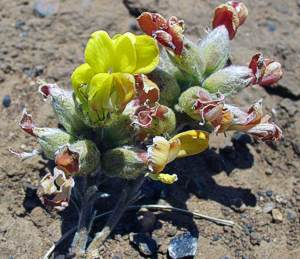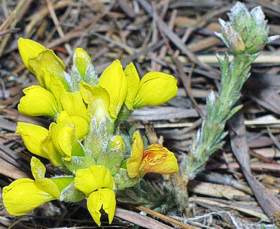Pearsonia sessilifolia
Pearsonia sessilifolia (Harv.) Dummer
Family: Fabaceae
Common names: silwerertjietee, vaalertjietee (Afr.)
Introduction
The sulphur-yellow flowers of Pearsonia sessilifolia, once pollinated, turn bright organge, signalling to their pollinators to reserve their resources and focus on the other bright yellow flowers, not the orange!

Description
Description
Pearsonia sessilifolia is a considerably variable species and currently four subspecies are recognised. They are distinguished on the basis of their distribution, bracteole shape and size, and leaflet characteristics such as the width to length ratio and amount of hairs present.



Single, slender stems, 0.1-1.2 m high, arise from a woody, suffrutescent rootstock. Depending on age and subspecies, they may be sparsely hairy to tomentose. Leaves are characteristically without any stipules. Leaves are typically sessile and trifoliate. Leaflets may be almost hairless to tomentose and usually silvery-grey in appearance due to the surface hairs.
Flowers are clustered together and borne on the top of branches. The petals are yellow, turning orange when pollinated, and the flowers are pea-like. Flowering time is in early spring, but the plant has been known to flower in autumn as well. Pods are narrow and oblong in shape, silvery tomentose, containing many small black seeds.
Conservation Status
Status
None of the species of Pearsonia is currently listed as threatened.
Distribution and habitat
Distribution description
Pearsonia sessilifolia can be found in the northern and eastern South African provinces of Limpopo, North-West, Gauteng, Mpumalanga and KwaZulu-Natal. The species also occurs in Swaziland and its distribution extends north towards the eastern parts of Zimbabwe. The plants can be found in grasslands, both dry and moist, as well as in the Kalahari-Highveld regional transition zone.
Usually the plants grow amongst rocks within open grassy areas. The species is extremely well adapted to grassland-shaping forces such as frequent winter frost and fires. Since they store all their accumulated resources in an underground rootstock, they simply resprout after a fire, producing masses of flowers regardless of rainfall.
Derivation of name and historical aspects
History
The genus Pearsonia is named in honour of Dr. H.H.W. Pearson (1870-1916), the first director of the Kirstenbosch National Botanic Garden. The specific epithet, sessilifolia, is Latin meaning 'stalk-less leaves' alluding to the sessile habit of the leaves.
The genus is relatively small compared to many of the other legume genera with only 13 species. Twelve of these occur in southern Africa and only one species ( P. madagascariensis ) occurs disjunctly in Madagascar — this is indeed an interesting distributional record for the genus, since it is only known from maritime sites in north-western Madagascar and not in the central highlands where most of the taxa with Afromontane connections occur.
In terms of the morphology (form and structure), the genus is very similar to Lotononis, but differs in having a gullet-type pollination mechanism. Chemically, the plants are noted for their accumulation of unique esters of quinolizidine alkaloids. From an evolutionary point of view, only two other genera share these features with Pearsonia, namely Rothia and Robynsiophyton.
Ecology
Ecology
Pearsonia sessilifolia is noted for its gullet-type pollination mechanism. This specific type of pollination is more commonly known from the Lamiaceae and Scrophulariaceae which also have zygomorphic (having only one plane of symmetry) flowers. The flowers have a landing place for pollinators, namely the lower lip. The sexual organs (stamens and pistil) are arranged on the upper side of the flower. When a pollinator's attention is attracted to the yellow flowers, it lands on the lower lip and starts moving into the flower to forage for nectar. Pollen is then deposited on its back and the upper part of its head. Pearsonia sessilifolia is assumed to be pollinated by different types of bees.
Another interesting member of the genus is P. metallifera, a species specially adapted to grow on the serpentine-rich soils of Limpopo and, more commonly, the Great Dyke in Zimbabwe. The plant can accumulate up to 15.3% nickel and 4.8% chromium.
Uses
Use
These plants do not elicit much excitement as horticultural specimens. No recorded traditional uses for this species are known.
Growing Pearsonia sessilifolia
Grow
Due to the very complex interactions between the environment and the grassland flora, it is typically difficult to cultivate plants from the wild. By studying the phenology (the periods when and for how long the plants flower, fruit, produce seeds etc.), one may be able to make accurate assumptions as to when would be the best times to plant the seeds. The important thing to remember when trying to grow seeds from the wild is that natural environmental conditions should be simulated as far as possible. For example, always use the same type of soil that the species normally grows in and make mental notes of the specific growing conditions of the plants in the wild when collecting seeds. Pearsonia sessilifolia is known to grow amongst rocks in grasses and would therefore not necessarily germinate and grow in a shady spot in the garden. Seeds should be sown late in winter or early spring and watered regularly until they germinate. Remember that the plants have large rhizomatous rootstocks and should be planted in their permanent place of residence as soon as the seeds germinate. Once planted, P. sessilifolia should not be removed because damage to the roots could cause the plant to die.
References
- Faegri, K. & Van der Pijl, L. 1971. The principles of pollination ecology. Pergamon Press, Oxford.
- Germishuizen, G. & Fabian, A. 1997. Wildflowers of northern South Africa. Fernwood Press, Vlaeberg, Cape Town.
- Leistner, O.A. (ed.). 2000. Seeds plants of southern Africa : families and genera. Strelitzia 10. National Botanical Institute, Pretoria.
- Lewis, G., Schrire, B., Mackinder, B. & Lock, M. (eds) 2005. Legumes of the world. Royal Botanic Gardens, Kew.
- Polhill, R.M. 1974. A revision of Pearsonia (Leguminosae-Papilionoideae). Kew Bulletin 29(2): 383-410.
- Smith, C.A. 1966. Common names of South African plants. Memoirs of the Botanical Survey of South Africa No. 35.
- Van Wyk, B.-E. & Verdoorn, G.H. 1989. Chemotaxonomic significance of alkaloids in the genus Pearsonia. Biochemical Systematics and Ecology 17(5): 391-394.
Credits
Alicia Grobler
National Herbarium, Pretoria
December 2008
Plant Attributes:
Plant Type: Perennial
SA Distribution: Gauteng, KwaZulu-Natal, Limpopo, Mpumalanga, North West
Soil type:
Flowering season: Early Summer
PH:
Flower colour: Yellow, Orange
Aspect: Morning Sun (Semi Shade), Afternoon Sun (Semi Shade)
Gardening skill: Challenging
Special Features:
Horticultural zones









Rate this article
Article well written and informative
Rate this plant
Is this an interesting plant?
Login to add your Comment
Back to topNot registered yet? Click here to register.